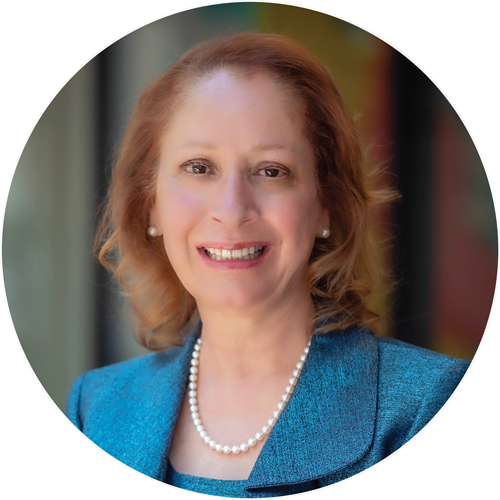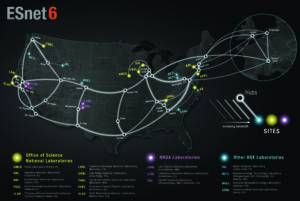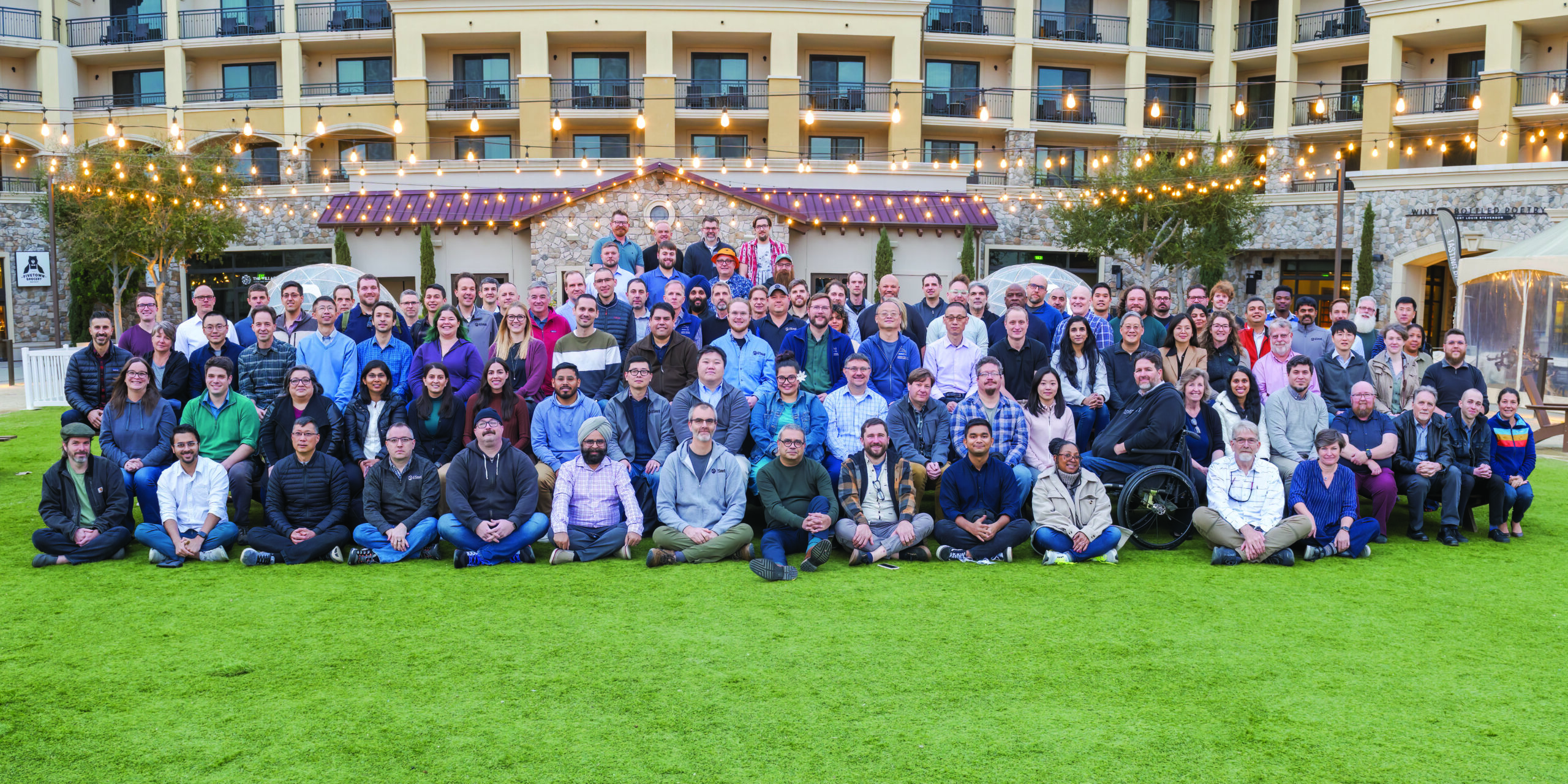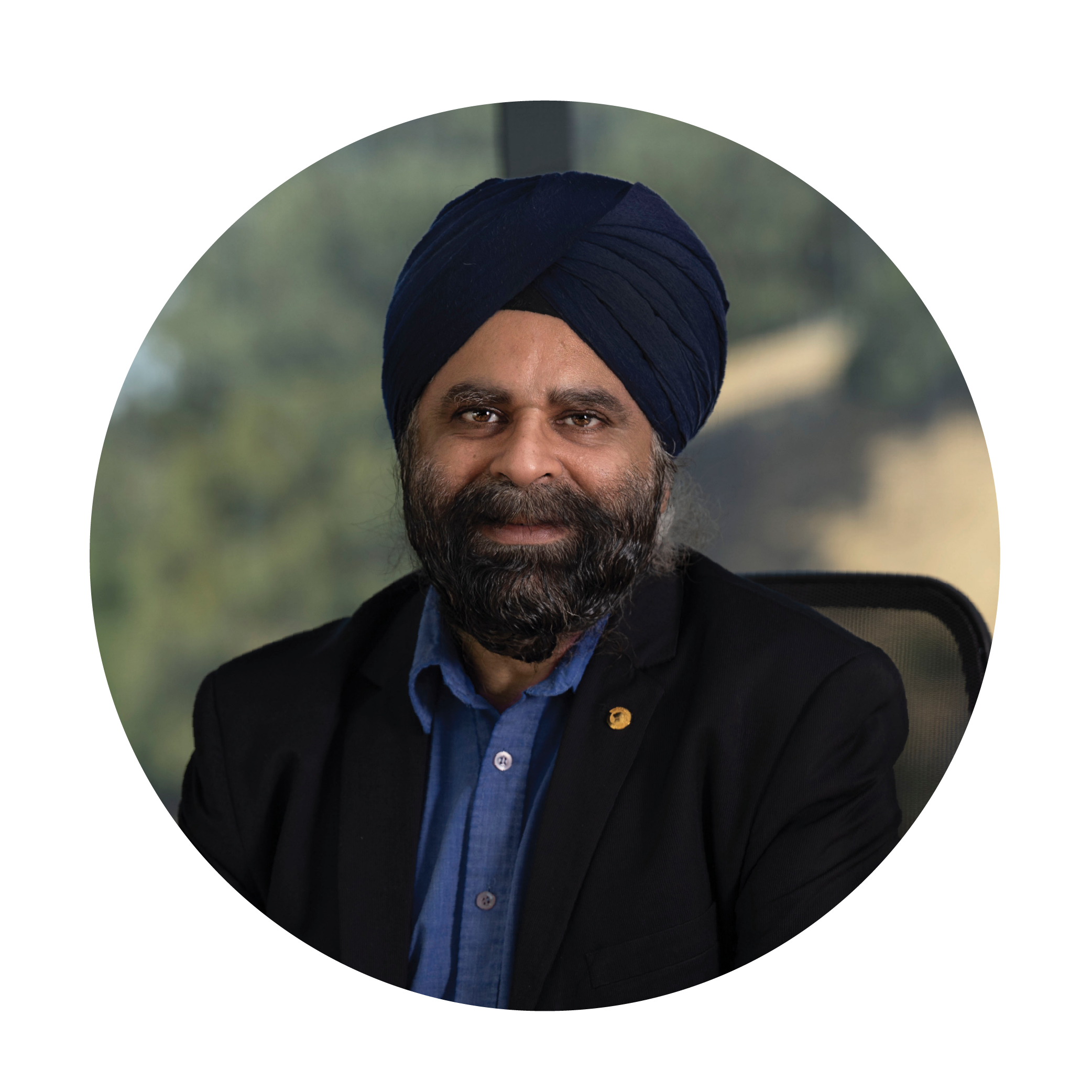When Inder Monga joined the Energy Sciences Network (ESnet) in 2009, the modest 40-person organization was managing its fourth iteration of the Department of Energy’s national network for scientific research and working on its fifth, ESnet5, which would attempt speeds of 100 gigabits per second (Gbps). Fast forward 15 years, and Monga has been Executive Director of ESnet and head of the Scientific Networking Division at Lawrence Berkeley National Laboratory (Berkeley Lab) for almost a decade, steering the organization through an era of unprecedented growth and innovation. Under his visionary leadership, ESnet has expanded to nearly 150 staff and contractors, established a sprawling network across the United States with connections to Europe, and achieved a staggering capacity of 1.5 terabits per second (Tbps).
Monga’s tenure as director has been marked by remarkable milestones, including the design, development, and launch of ESnet6 in 2022—an ambitious project that was completed ahead of schedule and under budget. This state-of-the-art network facilitated the transit of 1.7 exabytes of traffic in 2023. As Monga continues to lead ESnet into the future, he and his talented team are already laying the groundwork for ESnet7. This next-generation network promises to incorporate even more agile, intelligent functions and data-centric services, leveraging cutting-edge technologies such as Artificial Intelligence for IT Operations (AIOps).
Beyond his operational role at ESnet, Monga is the lead Principal Investigator for the Quantum Application Network Testbed for Novel Entanglement Technology (QUANT-NET) research project, funded in 2021, and serves as Co-Principal Investigator for the National Science Foundation (NSF)-funded FABRIC testbed project, a groundbreaking national research infrastructure launched in 2023.
“I have watched ESnet evolve over many years and under more than one leader. Inder Monga stands out, not only for his impressive technical engineering talents, as evidenced by his 25 patents and multiple high-profile projects, but also for his rare ability to assemble, inspire, and lead cross-functional teams with skills far beyond his own expertise,” says Vint Cerf, known as one of the “Fathers of the Internet” and currently Vice President and Chief Internet Evangelist for Google. “Under Inder’s prescient leadership, ESnet has been persistently innovative, its impact reaching far beyond the federal government.”
“Inder Monga stands out, not only for his impressive technical engineering talents, as evidenced by his 25 patents and multiple high-profile projects, but also for his rare ability to assemble, inspire, and lead cross-functional teams with skills far beyond his own expertise. Under Inder’s prescient leadership, ESnet has been persistently innovative, its impact reaching far beyond the federal government.”
— Vint Cerf
Vice President and Chief Internet Evangelist, Google
The Early Years: Role Models and Modems
Monga’s journey to leading one of America’s most important research networks began in Ranchi, a small town in India. His family lived in a colony for civil servants established by the government post-independence, where he was surrounded by children of engineers and innovators. This environment fostered a cosmopolitan viewpoint from a young age and helped fuel his academic ambitions, leading him to earn a bachelor’s degree in electrical engineering from the Indian Institute of Technology at Kanpur and to leave India to pursue a master’s in computer engineering at Boston University (BU).
In the early 1990s, as the Internet and network connectivity were rapidly evolving, Monga found himself at the forefront of technological advancements that would help shape his career. “At the time, we had modems we used to dial in from home to complete our work,” recalls Monga. “Soon Integrated Services Digital Network (ISDN) was introduced, offering a faster way for telephone providers to deliver data access at home. This higher-quality technology sparked my interest and became the focus of my master’s thesis project at BU.”
Monga had begun a Ph.D. at BU focused on ISDN when Wellfleet Communications, a well-known, fast-growing networking startup in the Boston area, hired him directly from campus to integrate this technology into their product. During this exciting growth period in networking, he was involved in several cutting-edge projects and quickly grew into a technical leadership role. Here he gained valuable experience in integrating different remote access technologies and exploring multicast and IP security.
In 1999, he moved to a management role, leading the IP Security team within the routing and switching business unit at Nortel. The following year, he became the director of software for an internal startup at Nortel, where he led the innovation and software development for the Optical Service Agent, which evolved into the DRAC product.
“We had a great idea for an internal startup that would merge optical capabilities and routers together into one platform,” explains Monga. However, the 2001 telecom crash sidelined the project, and he transitioned into the Office of the Chief Technology Officer (CTO). In this role, he deepened his understanding of research writing and the frustrations of promoting new ideas, securing 25 patents and leading a research group focused on high-performance networking.
“After a decade at Nortel, I had reached a stage where I had built a lot of products and explored new ideas that were focused on the customers’ needs,” Monga says. “I wanted to see network design and development from the customer’s perspective and understand how service providers like Verizon, AT&T, etc made buying decisions. This desire led me to ESnet to explore bridging the gap between application needs and network capabilities.”
ESnet’s stated mission is “to enable and accelerate scientific discovery by delivering unparalleled network infrastructure, capabilities, and tools.” It seeks to free scientific progress from the physical location of instruments, people, computational resources, or data. “We want to help scientists move from data to insight as quickly and seamlessly as possible,” says Monga. “With ESnet6, we aimed to provide the infrastructure that supports groundbreaking research and enables the next generation of scientific breakthroughs, empowering researchers to collaborate more effectively across disciplines and geographies.”
“ESnet is a critical pillar in connecting the Edge research community to the DOE’s national labs and enabling groundbreaking scientific discoveries. We have been fortunate to leverage the expertise of ESnet’s Science Engagement team in designing National Science Foundation Campus Cyberinfrastructure proposals and offering workshops and tutorials to our community. Their guidance has been instrumental in helping organizations enhance network performance. These efforts have enabled secure, high-speed data transfers at institutions, significantly strengthening the region’s cyberinfrastructure and advancing its research capabilities.”
— Forough Ghahramani, Ed.D.
Assistant Vice President for Research, Innovation, and Sponsored Programs, Edge

ESnet6 provides an expanded, dedicated fiber-optic backbone, with new network automation capabilities, improved cybersecurity features, and real-time telemetry. “This network was built from scratch on fiber, all the way from the optical layer to the networking layer,” Monga explains. “The core design was focused on building strong partnerships with our users and understanding their workflows to help them use network features more efficiently and be successful.”
Recognizing the importance of software in modern networking, Monga also prioritized building a robust software engineering team at ESnet. “Today, our software engineering team is equal in strength to our network engineering team,” he says proudly. “We have accomplished a great deal in orchestration and automation while also learning about institutionalizing advanced research and development.” Leveraging his innovation experience at Nortel, Monga is successfully capitalizing on the operational and deployment expertise within the ESnet organization to build an effective pipeline where staff can develop new ideas and move them through to production.
Accelerating Science Workflows
A recent example of such an idea, now in an advanced prototype phase, is an ESnet collaboration with Thomas Jefferson National Accelerator Facility (Jefferson Lab). The ESnet-JLab FPGA Accelerated Transport (EJ-FAT) device is a real-time load balancer that uses Field Programmable Gate Array (FPGA) technology to enable real-time data streaming from various scientific instruments, such as particle accelerators, X-ray light sources, and electron microscopes, across the country via ESnet6 to multiple high-performance computing facilities, where it is processed and returned in time to allow useful adjustments to experiments.
These facilities’ time-sensitive workflows are driven by high-speed A/D data acquisition systems (DAQs) that can produce multiple 100- to 400-Gbps data streams—a firehose of raw data. “ESnet is interested in accelerating the transport of data,” explains Monga. “For the past two decades, the networking community has primarily focused on moving scientific data in the form of files. This approach, which is seen in initiatives like Globus and Grid-FTP, works by collecting data from instruments, saving it as files, and then transferring it to computing resources for analysis. However, with the high rates at which massive volumes of data are generated by modern instruments and sensors, the process of storing massive datasets in files and moving them often involves multiple steps, making it time-consuming and inefficient—especially when researchers are trying to gain immediate insights.”
EJ-FAT has successfully streamed data from Jefferson Lab in Virginia to the National Energy Research Scientific Computing Center (NERSC) in Berkeley, California, and the Oak Ridge Leadership Computing Facility in Tennessee at 100 Gbps, allowing these challenges to be sidestepped. The prototype is designed to run on a large number of comparable instruments within the DOE complex, and the ESnet-Jefferson Lab project team is working with researchers at the Advanced Light Source at Berkeley Lab, the Advanced Photon Source at Argonne National Laboratory, and the Facility for Rare Isotope Beams at Michigan State University. The goal is to refine it further with support from both the scientific and computing communities to eventually turn it into a full production system.
 This could be transformative. For example, a graduate student at a research facility may spend months preparing for a beamline experiment, collecting data, and then finding that the sample was not positioned correctly, requiring a redo of the entire experiment. With real-time streaming, data can be analyzed as it’s collected, offering immediate feedback and minimizing the risk of errors. Additionally, the data can be processed at high-performance computing centers, even when the raw data is too large to store locally on hard drives or too fast for a laptop to handle.
This could be transformative. For example, a graduate student at a research facility may spend months preparing for a beamline experiment, collecting data, and then finding that the sample was not positioned correctly, requiring a redo of the entire experiment. With real-time streaming, data can be analyzed as it’s collected, offering immediate feedback and minimizing the risk of errors. Additionally, the data can be processed at high-performance computing centers, even when the raw data is too large to store locally on hard drives or too fast for a laptop to handle.
“ESnet cannot innovate in a vacuum—we must understand what problems our customers are facing. Instead of developing a product that we push on them, we try to engage scientists in a way that we can develop a solution to a problem together from both a networking and a science workflow perspective,” explains Monga. “This collaborative, co-design approach ensures that the technologies we create are not only groundbreaking but also directly aligned with the needs of the scientific community.”
In addition to ESnet’s active collaborations between its network and software engineers and science users, the organization plays a mostly invisible but nonetheless key supporting role in enabling the collaborations of tens of thousands of DOE-funded scientific researchers in the United States and Europe through its high-performance network itself. ESnet6 links together the DOE’s 17 national laboratories, 28 user facilities, and additional scientific instruments such as the NSF–DOE Vera C. Rubin Observatory in Chile and the CERN particle physics laboratory in Geneva at blazing fast speeds. It’s thus become a critical ingredient to the success of the Integrated Research Infrastructure (IRI) framework created by the DOE Office of Science’s Advanced Scientific Computational Research (ASCR) program. The goal of IRI (www.iri.science) is to seamlessly link DOE’s experimental and observational scientific user facilities, data assets, and advanced computing resources so that researchers can combine these tools in novel ways that radically accelerate discovery.
In 2023, ESnet hosted its second annual gathering for its science users, called Confab. Confab23 brought together more than 160 DOE–funded domain scientists, computer scientists, network engineers, DOE program managers, and user facility staff interested in finding new ways to collaborate. Its theme was “Co-Designing the Future of National-Scale Integrated Science and Networking,” inspired by the DOE’s vision for IRI.
“ESnet’s Confab23 user meeting provided a great opportunity to hear from the research community, learn about the Department of Energy’s world-class research tools, infrastructure, and user facilities accelerating discovery and innovation, and network with distinguished colleagues from across the nation,” said Dr. Forough Ghahramani, Edge’s Assistant Vice President for Research, Innovation, and Sponsored Programs, who attended the gathering.
In the months since Confab23, ESnet staff have continued to help develop IRI, serving in important leadership roles and on the three technical subcommittees. From April 7-9, 2025, ESnet will convene Confab25 (confab25.es.net), its third science-user gathering, which will be partly devoted to progress updates and success stories from IRI.
ESnet’s importance to ASCR’s strategic future has been acknowledged publicly. “Without ESnet, the entire vision collapses; none of the facilities, nor the integrated ecosystem, nor IRI could function,” stated the Advanced Scientific Computing Advisory Committee (ASCAC) in a presentation summarizing plans for the ASCR facilities’ next 10 years.

Strengthening the Research & Education Community
As important as ESnet is to the DOE ecosystem, the organization also looks outside the government for inspiration, knowledge sharing, and partnership. ESnet6 connects to more than 270 research, education, and commercial networks in five countries through peering agreements.
“We need to create opportunities and pathways for collaboration within the research and education ecosystem and share our capabilities more effectively,” says Monga. ESnet is part of the global R&E community—Monga and numerous ESnet staff members are frequent speakers at conferences and meetings around the world—and several years ago it partnered with SURF, which created and maintains SURFnet, the national research and education network of the Netherlands, on an open-source Workflow Orchestrator software that automates the provisioning of networks. “Partnerships are extremely important for ESnet, especially in the research and education space,” he explains. “Just as we partner with our scientific users to identify where they’re getting stuck, we collaborate with our R&E colleagues to solve problems, share knowledge and resources.”
In January 2024, ESnet teamed up with GÉANT, GlobalNOC at Indiana University, Internet2, and Texas Advanced Computing Center (TACC) to form the consortium MetrANOVA, for Advancing Network Observation, Visualization, and Analysis. Led by ESnet, MetrANOVA is working to develop and disseminate common network measurement and analysis tools, tactics, and techniques.
ESnet has long partnered with Internet2, GÉANT, CANARIE, and others in the Advanced North Atlantic (ANA) collaboration (www.anaeng.global), and in March 2024 those four organizations announced a major expansion of 400 Gbps transoceanic circuit capacity dedicated to transferring R&E data, a significant achievement in high-speed connectivity between North America and Europe.

Since Monga joined ESnet in 2009, the organization has grown from a staff of 40 to more than 150, including software as well as network engineers, researchers, and support staff. Photo: Paul Porter, ESnet
“Forward-looking vision and a deep commitment to collaboration drive progress in the research and education community. Under Inder Monga’s leadership, ESnet exemplifies this ethos—working alongside global R&E partners to advance the perfSONAR project, establish the MetrANOVA consortium, and reach new milestones in expanding trans-Atlantic connectivity,” says Howard Pfeffer, President and CEO at Internet2. “Together, these collective efforts strengthen the global R&E network fabric, ensuring scientists and scholars have the robust infrastructure, capabilities, and support needed to accelerate discovery and innovation.”
And of course, ESnet collaborates with Edge. “To advance the broader mission of research and education within the U.S., we need organizations like Edge to help strengthen the ecosystem, ensuring that critical resources and knowledge are shared across institutions,” says Monga.
According to Dr. Ghahramani, “ESnet is a critical pillar in connecting the Edge research community to the DOE’s national labs and enabling groundbreaking scientific discoveries. We have been fortunate to leverage the expertise of ESnet’s Science Engagement team in designing National Science Foundation Campus Cyberinfrastructure proposals and offering workshops and tutorials to our community. Their guidance has been instrumental in helping organizations enhance network performance. These efforts have enabled secure, high-speed data transfers at institutions, significantly strengthening the region’s cyberinfrastructure and advancing its research capabilities.”
“My advice to others is to find a balance between leadership and collaboration. As a leader, it’s crucial to get your hands dirty—to truly understand the challenges at the ground level. Only then can you effectively guide, inspire, and lead your team.”
— Inder Monga
Executive Director, ESnet
Head of the Scientific Network Division, Lawrence Berkeley National Laboratory

Designing the Network of the Future
Looking forward, the rapid evolution of artificial intelligence (AI) and quantum computing technologies is taking ESnet in new directions.
“AI can be enormously useful for analyzing, modeling, and predicting network traffic, but we must first determine how to use these tools to handle tickets, help restore outages, or simplify the design of protocols safely and reliably,” says Monga. “Perhaps AI can be used to automate parts of the network and provide insights into capacity planning. We will also need to increase our networking capacity as more scientists use AI techniques and workflows and data needs change. AI will likely change how we think about network design and provide services.”
Meanwhile, as the quantum computing ecosystem scales up, quantum networking must keep pace—which is what Monga and the Quantum Application Network Testbed for Novel Entanglement Technology (QUANT-NET) team are working on. QUANT-NET is a five-year, multi-institutional project (currently in its fourth year). Its world-leading experts, based at Berkeley Lab, University of California, Berkeley (UC Berkeley), the California Institute of Technology, and the University of Innsbruck, have constructed a testbed for quantum networking technologies. Their goal is to establish a three-node distributed quantum computing network between Berkeley Lab and UC Berkeley, connected with an entanglement swapping substrate over optical fiber and managed by a quantum network protocol stack.
Led by Monga, the project was designed with an application-driven approach, prioritizing real-world use cases over merely demonstrating networking technology. “The goal was to create a testbed that allows different teams to contribute their innovations to the field without the high cost of developing their own quantum infrastructure,” explains Monga. Given the complexity and expense of quantum system development, including challenges like supply chain delays for critical components, the testbed plans to provide a platform for experimentation.
To date, much of the focus on quantum technologies has been on Quantum Key Distribution (QKD) for security. QUANT-NET’s focus is on enabling communication between multiple quantum computers. “Although this capability is still five to seven years away, early research is laying the groundwork by exploring how classical, physical, and optical networks can support the future of quantum computing,” Monga says.
“Emerging technologies like AI and data are the focus of today, but just as we’ve integrated technologies like the internal combustion engine in the past, we must continue to embrace and integrate new technologies with a thoughtful, balanced approach.”
— Inder Monga
Executive Director, ESnet
Head of the Scientific Network Division, Lawrence Berkeley National Laboratory

Advancing Forward with Curiosity
As an organization, Monga says ESnet approaches networking from two perspectives. “First, we focus on building networks that accelerate any kind of scientific research. Second, we are dedicated to advancing the science of networking itself through applied research and development. In other words, our work is not just about applying new technologies like AI or quantum computing, but also about improving how we build and operate networks more efficiently, using tools such as the Workflow Orchestrator and partnerships that will expand our trans-Atlantic spectrum and bandwidth. This dual focus drives our agenda for innovation, as we seek to both support scientific progress and enhance the capabilities of the networks that make that progress possible.”
Monga’s decades of experience in commercial and government-funded technology organizations have taught him that balancing operational goals with innovation is essential, ensuring that enthusiasm for new technologies doesn’t cloud practical decision-making. “Emerging technologies like AI and data are the focus of today, but just as we’ve integrated technologies like the internal combustion engine in the past, we must continue to embrace and integrate new technologies with a thoughtful, balanced approach,” he warns.
“Forward-looking vision and a deep commitment to collaboration drive progress in the research and education community. Under Inder Monga’s leadership, ESnet exemplifies this ethos—working alongside global R&E partners to advance the perfSONAR project, establish the MetrANOVA consortium, and reach new milestones in expanding trans-Atlantic connectivity. Together, these collective efforts strengthen the global R&E network fabric, ensuring scientists and scholars have the robust infrastructure, capabilities, and support needed to accelerate discovery and innovation.”
— Howard Pfeffer
President and CEO, Internet2
For emerging leaders and researchers who want to contribute to large-scale scientific networks and infrastructure, Monga urges them to be curious and focus on understanding the ins and outs of a problem. “I see many people spend all their time pushing a solution. I think it’s more important to spend time asking questions and diving into the problem you’re trying to solve. Because if you’re working on the right problem, even if the solution is not 100%, it will have a much larger impact than if you build an elegant solution for a problem that is not relevant. It’s important to ask, ‘Is this the problem worth solving?’ and ‘Will it truly make a difference?’”
“I see many people spend all their time pushing a solution. I think it’s more important to spend time asking questions and diving into the problem you’re trying to solve. Because if you’re working on the right problem, even if the solution is not 100%, it will have a much larger impact than if you build an elegant solution for a problem that is not relevant. The key to success lies in focusing on solving the right challenges with meaningful impact, rather than spending excessive time marketing solutions. It’s important to ask, Is this the problem worth solving? and Does it truly make a difference?”
— Inder Monga
Executive Director, ESnet
Head of the Scientific Network Division, Lawrence Berkeley National Laboratory

He continues, “My advice to others is to find a balance between leadership and collaboration. As a leader, it’s crucial to get your hands dirty—to truly understand the challenges at the ground level. Only then can you effectively hire, guide, inspire, and lead your team. It’s a fine line, but the ability to perceive the complexity without taking on all the work is essential for both personal and collective success. I am incredibly proud to have assembled the ESnet team, comprising leading experts in our field who are full of passion, imagination, and creativity.”
It’s a philosophy that has served Monga well in his career, and one that should ensure the continued growth and innovation of ESnet as well as his ambitious research projects.


